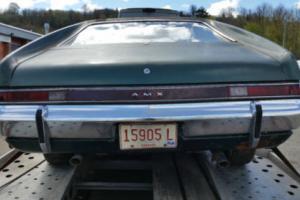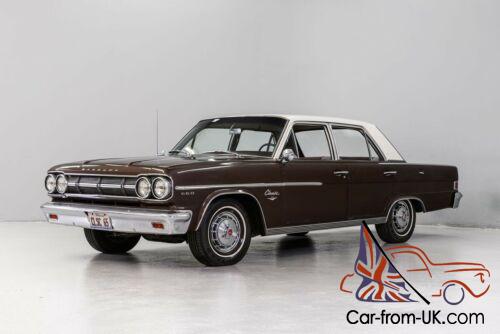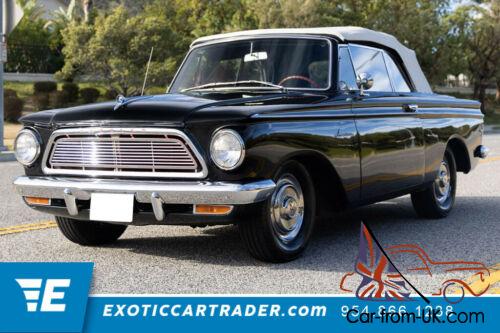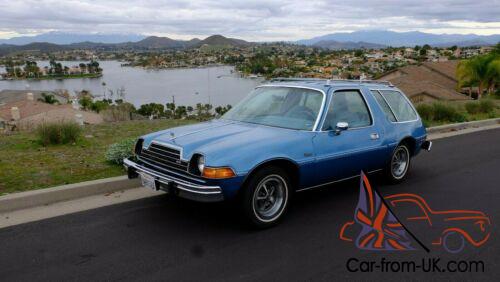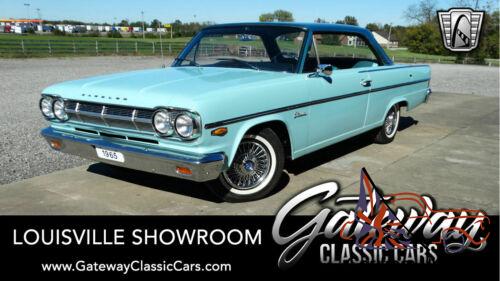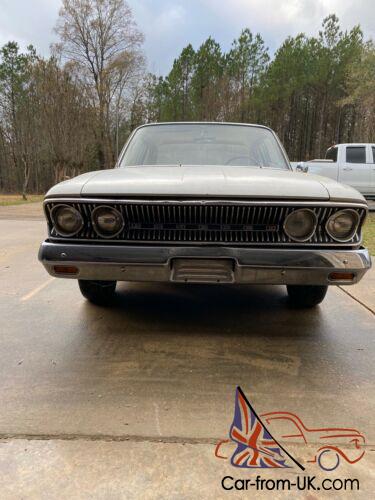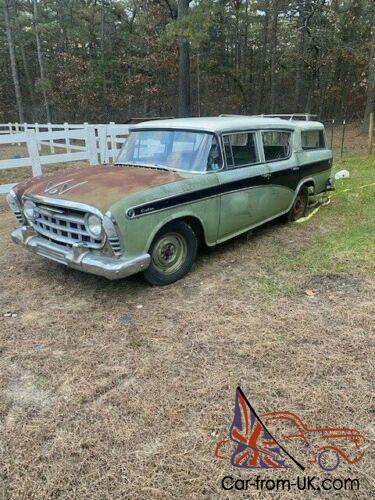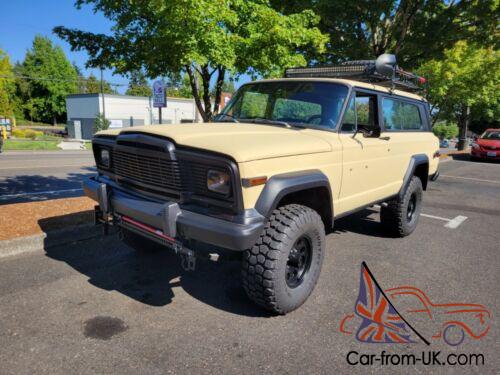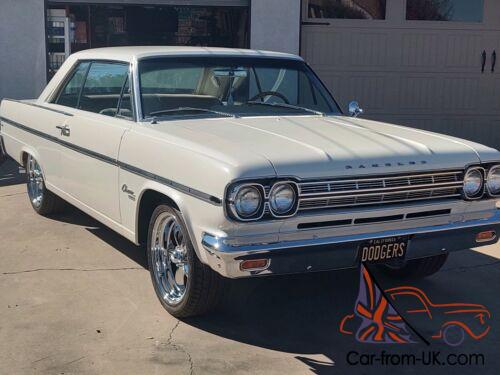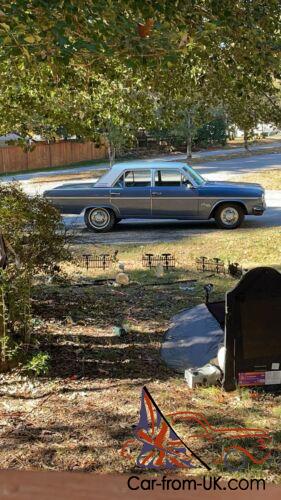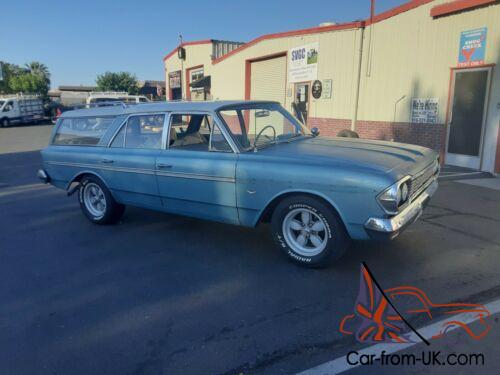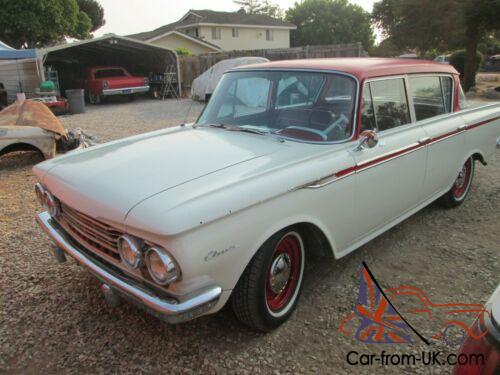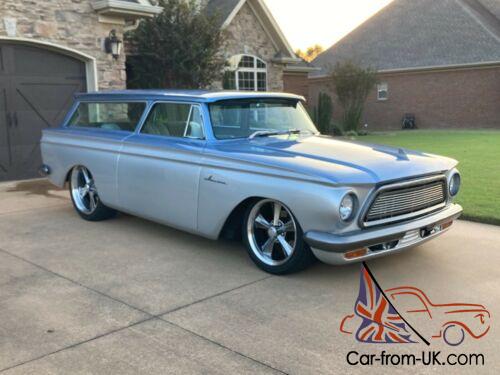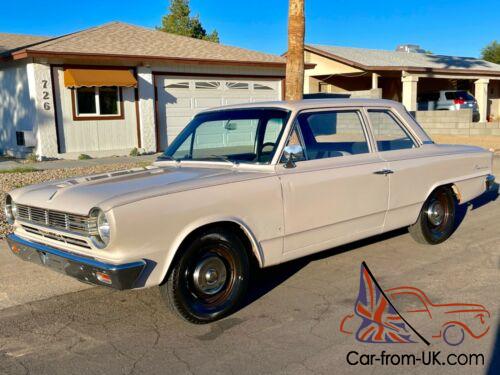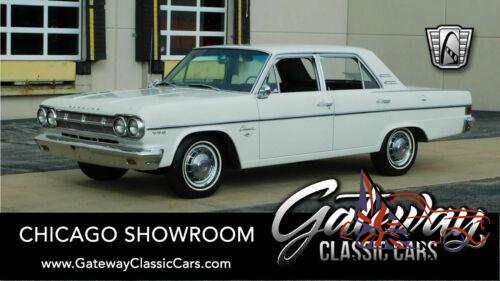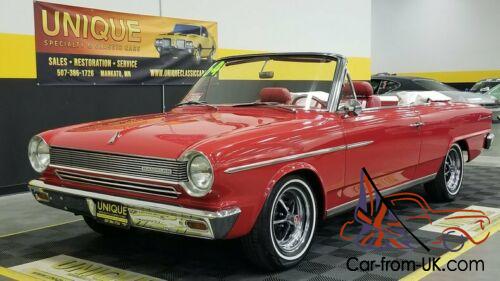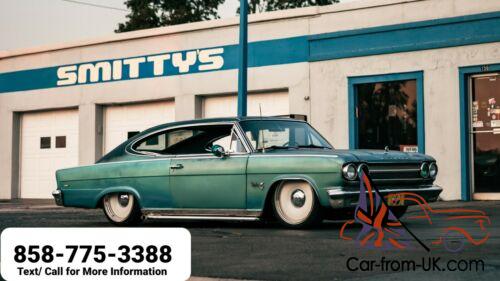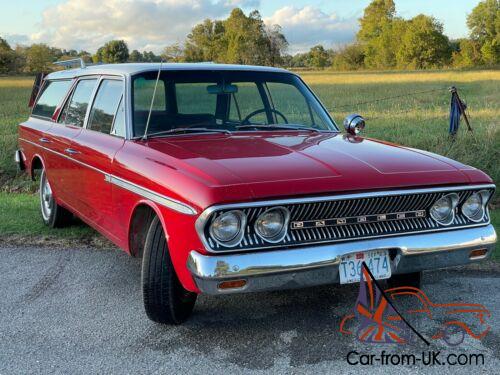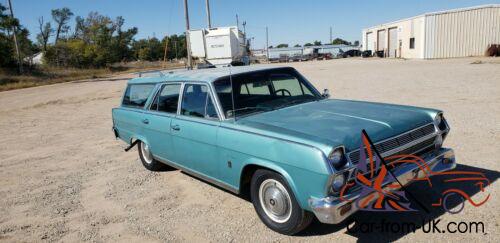Classic Cars / AMC / Car for sale
69 AMX MUSCLE CAR 390 AUTO
Sale price: £8,250.00 Make an offer
Car location: United Kingdom
Sale type: Fixed price listing
Technical specifications, photos and description:
- Make:
- Citroen
- Model:
- AMX
- Year:
- 1969
- Type:
- Coupe
- Doors:
- 2
- Color:
- Green
- Engine:
- 6,300
- Transmission:
- Automatic
- Got questions?
- Ask here!
69 AMX MUSCLE CAR 390 AUTO for sale
Current customer rating:
69 AMX BARN FIND BEEN PARKED UP FOR 25 YRS VERY RARE CAR FROM AMC 2 SEATER AMX WITH BIG BLOCK 390 AND AUTO TRANS AND POSI DIFF ONE OF 2000 390/AUTO COMBOS BUILT THIS ONE COMES WITH FACTORY GO-PACK. ENGINE TURNS FREELY BUT NOT HAD IT RUNNING YET. COLOR IS HUNTER GREEN WITH CHARCOAL INTERIOR. NEEDS FULL RESTORATION. SEE INFO BELOW IF YOU NEVER HEARD OF THESE CARS BEFORE. NUMBERS MATCHING. ALL DUTIES PAID AND NOVA CERT/TITLE IN HAND. ENQUIRE FOR MORE INFO/PICS
AMC AMXFrom Wikipedia. the free encyclopedia
For the AMC AMX of 1978. see AMC Concord . For 1979-1980. see AMC Spirit . AMC AMX 1968 AMX with "Go-Package"Overview Manufacturer American Motors Corporation Also called Rambler AMX ( Australia ) [1] Production 1968–1970 Assembly Kenosha. Wisconsin . United States Port Melbourne . Australia ( AMI ) [1] Designer Richard A. Teague Body and chassis Class Grand tourer . Muscle car . Sports car
[2] [3] [4] Body style 2-door coupe Layout FR layout Platform AMC's “junior cars”Powertrain Engine 290 cu in (4. 8 L) 4-bbl V 8 225 hp (168 k W 228 PS) 1968-69343 cu in (5. 6 L) 4-bbl V 8 280 hp (209 k W 284 PS) 1968-69360 cu in (5. 9 L) 4-bbl V 8 285 hp (213 k W 289 PS) 1970390 cu in (6. 4 L) 4-bbl V 8 315 hp (235 k W 319 PS) 1968-69390 cu in (6. 4 L) twin 4-bbl V 8 340 hp (254 k W 345 PS) 1969 SS (only)390 cu in (6. 4 L) 4-bbl V 8 325 hp (242 k W 330 PS) 1970 Transmission 4-speed manual floor shift (standard)3-speed "Shift-Command" automatic on console Dimensions Wheelbase 97 in (2. 64 mm)Length 1968-69: 177 in (4. 96 mm)1970: 179 in (4. 47 mm)Width 71 in (1. 03 mm)Height 51 in (1. 95 mm) Curb weight Approximate: 3. 00 lb (1. 61 kg)
The AMC AMX is a two-seat GT -style sports car that was produced by American Motors Corporation for the 1968 through 1970 model years . [2] The AMX was also classified as a muscle car . but "unique among other American cars at the time due its short wheelbase ". [5] The AMX was also the only American-built steel-bodied two-seater of its time. the first since the 1955-1957 Ford Thunderbird . [6] To a degree. the AMX was a competitor with America's only other two-seater of the era. the Chevrolet Corvette [7] for substantially less money. [6] With a one-inch (2. 5 cm) shorter wheelbase than Chevrolet's two-seater. the AMX was often seen by the press as a "Corvette competitor" [8]
Fitted with the optional high-compression medium block 390 cu in (6. 4 L) AMC V 8 engine . the AMX offered top-notch performance at an affordable price. In spite of this value and enthusiastic initial reception by automotive media and enthusiasts. sales never thrived. However. the automaker's larger objectives to refocus AMC's image on performance and to bring younger customers into its dealer showrooms was achieved. After three model years. the two-seat version was discontinued. and the AMX's now signature badging was transferred to a high-performance version of its four-seat sibling. the Javelin . from 1971-1974.
American Motors capitalized the respected reputation of the original AMXs by reviving the model designation for performance-equipped coupe versions of the compact
Hornet in 1977. Concord in 1978. and the subcompact Spirit in 1979 and 1980.
Contents
[ hide ]
1 Origin of the AMX
2 Record-breaking
3 Industry firsts
4 1968
4. 1 Breedlove AMX
4. 2 Hertz rent-a-racer
5 1969
5. 1 California 500
5. 2 Super Stock AMX
5. 3 Playmate AMX
5. 4 Pikes Peak cars
5. 5 AMX-R
6 1970
7 Performance figures
7. 1 Racing
8 Production
8. 1 Assembly in Australia
9 Concept and show cars
9. 1 AMX/2
9. 2 AMX GT
9. 3 AMX-400
9. 4 AMX/3
9. 5 1971 Teague AMX
10 Collectibility
10. 1 Number matching
10. 2 Scale models
11 See also
12 Footnotes
13 External links
Origin of the AMX
[ edit ]
1968 and 1969 C-pillar AMX emblem
1969 AMC AMX in "Matador Red"
The AMX name originates from the "American Motors e Xperimental" code used on a concept vehicle and then on two prototypes shown on the company's "Project IV" automobile show tour in 1966. [9] One was a fiberglass two-seat "AMX". and the other was a four-seat "AMX II". Both of these radically styled offerings reflected the company's strategy to shed its "economy car" image and appeal to a more youthful. performance-oriented market. [9]
The original AMX full-scale models were developed in 1965 by AMC's advanced styling studios under the direction of Charles Mashigan. [9] The two-seat AMX was "big hit on the auto show circuit in 1966" and featured a rumble seat that opened out from the rear decklid for extra passengers called a "Ramble" seat. AMC executives saw the opportunity to change the consumers' perception of the automaker from Romney's economy car image. to the realities of the new marketplace interested in sporty. performance oriented vehicles.
Robert B. Evans requested a car like the AMX to be put into production quickly. [9]
Two simultaneous development programs emerged for a production car : one for a modified Javelin and another for a completely new car bodied in fiberglass. The first approach was selected allowing AMC to use its existing technology and unibody manufacturing expertise to make fairly inexpensive modifications to the Javelin approximating the prototype's styling and proportions. The automaker could turn out steel bodies in large numbers. so it rejected developing plastic (or fiberglass) bodies because those are intended only for low-production models. [10] The first fully operational unit debuted as part of AMC's AMX project in 1966. The once-"frumpy" automaker jumped on the "pony car bandwagon" with its "attractive Javelin" and soon introduced the "unique" AMX featuring a design where "hoods didn't come any longer. nor decks any shorter". [11]
Vic Raviolo. previously responsible for the Lincolns that raced in the Carrera Panamericana during the 1950 s was involved with engineering AMC's new sports-car-type coupe. [12] The AMX was the first steel-bodied. two-seat American performance car since the 1957 Thunderbird . Ford's original two-seater having long since evolved into a four-seat personal luxury car . The AMX was also the only mass-produced. domestic two-seater to share the market with Chevrolet's Corvette since the 1957 Thunderbird. [13] [14] With a short 97 in (2. 64 mm) wheelbase. the AMX's direct competition was the one-inch longer (98 inches (2. 89 mm) Chevrolet Corvette . The AMX's manufacturer's suggested retail price (MSRP) was US$ 3. 45 (US$22. 82 in 2016 dollars [15] ). nearly 25% below and over $1. 00 less than the Corvette's price tag. [16]
The AMX was introduced to the press at the Daytona International Speedway on 15 February 1968 just over four months after the Javelin went on sale. In the demonstrations on the race track. the new AMXs ran at speeds up to 130 mph (209 km/h). American Motors' group vice president. Vic Raviolo. described the AMX as "the Walter Mitty Ferrari. " [17] The AMX was designed to "appeal to both muscle car and sports car enthusiasts. two camps that rarely acknowledged each other's existences. " [3] The problem was the "tire-melting" acceleration of the two-seater made it "a quick car that handled like a sports car. confusing the buying public. " [3] Automotive journalist Tom Mc Cahill summed up. "the AMX is the hottest thing to ever come out of Wisconsin and . you can whip through corners and real hard bends better than with many out-and-out sports cars. " [12]
Record-breaking
[ edit ]
AMX "shatters" speed records in an advertisement for Champion spark plugs
In January 1968. two specially-prepared AMXs set 106 world speed and endurance records at Goodyear 's track in Texas driven by world land speed record holder Craig Breedlove . his wife Lee. and Ron Dykes. [18] [19] As a way to promote the new car. AMC's Performance activities manager. Carl Chakmakian. asked Breedlove to put the AMX through its paces before it was even available for sale. [20] Breedlove's "Spirit of America" crew and Traco Engineering had six weeks to prepare the cars before they were to be displayed at the Chicago Auto Show in February. [20]
The AMC V 8 engines . such as the 290 cu in (4. 8 L) engine in one car was bored out to 304 cu in (5. 0 L) and the 390 cu in (6. 4 L) in the other to 397 cu in (6. 5 L). The shop installed exhaust headers. eight-quart oil pans. oil coolers. hi-rise intake manifolds. racing camshafts with solid lifters and stronger springs. and larger carburetors. The cars had engine and rear-end oil coolers. and 37 US gal (140 L 31 imp gal) cell-type safety fuel tanks. Engine components were X-rayed and Magnafluxed to check for cracks. as were chassis components. [20]
Chassis preparation included heavy-duty front and rear springs (part of the factory's optional handling package). rear spring traction control arms. heavy-duty shock absorbers and a "panhard" type track bar in the rear to eliminate side sway. Stock wheels and tires were replaced by wide magnesium racing wheels and Goodyear racing tires. The cars were aerodynamically modified: the front ends were lowered. the hoods were slanted down and spoilers were installed below the front bumpers. The car interiors had structure-stiffening roll cages for driver protection. a stock bucket seat modified for additional support. and supplementary engine-monitoring instruments. [20]
Breedlove also took the AMX to Bonneville reaching 189 mph (304 km/h) in a United States Auto Club (USAC) sanctioned run. a rel="nofollow" href=" wikipedia. org/wiki/AMC_AMX#cite_note-stuffworks AMX-8" >[8] as well as an unofficial run of over 200 mph (322 km/h). [6]
Industry firsts
[ edit ]
The AMX was not only sporty and attractive. but it introduced many industry firsts. [21]
The American Society of Automotive Engineers named the AMX as the "best engineered car of the year" in 1969 and 1970. [22]
For its first year recognition. the reasons cited included the car's dashboard. which was injection-molded in one piece "for safety purposes. an industry first. " [21] The AMX's new 390 engine was developed to have a large displacement within its minimal external dimensions and moderate weight. while the use of common components and machining with AMC's 290 and 343 engines assured manufacturing economy. [23] The 1968 models also included an innovative fiberglass safety padding. a "plastic" on the inside of the windshield posts that was first used on the AMC Javelins.
For the following year's award. the citation included the 1970 AMXs (and Javelins) being the first production cars to use windshields that were safer. thinner. and lighter than ordinary laminated glass. [24] Developed by Corning . the glass featured a chemically hardened layer designed to give under impact and crumble into small granules to reduce injuries. [25] The inner layer has "stress raisers that will cause it to break before excessively high concussion forces can be developed in the occupant's skull. " [26]
American Motors also incorporated new designs for windshield sealing for the 1970 models. and developed a systems solutions process that began in the styling studio to insure maximum efficiency. [27]
1968
[ edit ]
1968 AMC AMX with Go-Pac
1968 AMC AMX with chrome wheels and red stripe tires standard with Go-Package
The "AMX 390" engine
American Motors promoted the mid-model year launch of the AMX to automotive journalists at Daytona to emphasize its sports car performance. as well as with a marketing agreement with Playboy Enterprises . [28] The AMX was introduced to the public on 24 February 1968. five months after the Javelin and other 1968 AMC cars. It was promoted as "the only American sports car that costs less than $3500". [29] American Motors advertisements also showed "a helmeted race driver revving up at the starting line in one of AMC's sporty AMX models. which it describes as ready to do 125 miles an hour. " [30]
The two-seat AMX was "meant for a small. well-defined market niche. and it pulled in young people into AMC dealer showrooms in never before seen numbers". [31] Numerous road tests described the new AMX as a "handsome two-seater with American-style acceleration and European-style handling". [31] Journalists gave it a real run workout on all kinds of terrain and wrote "that the AMX is one of the best-looking cars — if not the best-looking car — made in the U. S. A. " [32]
All AMXs came with four-barrel carbureted small block [33]
AMC V 8 engines in several versions: 290 cu in (4. 8 L) (225 hp (168 k W). N-code). 343 cu in (5. 6 L) (290 hp (220 k W). T-code). as well as the 390 cu in (6. 4 L) "AMX" featuring 315 hp (235 k W) with 425 pound force-feet (576 N·m) of torque (X-code). All derived from the same external sized block. However. the three engines differed vastly internally. with the smallest engine having small intake and exhaust valves. thin block webbing. and a cast nodular iron crankshaft the 343 used larger valves with a thicker block webbing and the 390 moved up to a forged steel crankshaft and connecting rods. as well as larger rod bearings. 2. 250 in (57. 15 mm) compared to 2. 090 in (53. 09 mm) in the smaller two versions. [34]
A Borg Warner T-10 four-speed manual transmission was standard. as were special traction bars. dual exhaust system. and fatter tires for better traction. A "Shift-Command" three-speed automatic transmission with the capability of manual shifting (Borg Warner model M-11 B or M-12) was optional together with a floor console mounted shifter.
A popular "Go-Package" option came with either the four-barrel 343 or 390 engine. and included power assisted front disk brakes. "Twin-Grip" differential . E 70 x 14 red-stripe performance tires on "Magnum 500" styled-steel wheels. heavy-duty suspension with thicker sway-bars. heavy-duty cooling. and other performance enhancements. [9] A wide range of specialized performance parts were also available through AMC dealers for installation on customer's cars. These were known as "Group 19" parts because of the way AMC organized its parts books. [35]
Breedlove AMX
[ edit ]
According to several sources. "Breedlove Replica" cars to commemorate the speed and endurance records were offered by AMC. [36] The Standard Catalog of American Muscle Cars 1960-1972 describes an estimated 50 "Breedlove" AMXs were sold featuring the red. white. and blue paint scheme along with the standard 4-barrel 290 cu in (4. 8 L) V 8 with four-speed manual transmission. [37]
However. AMC historians. argues there was no "factory literature. order sheets. advertising. photographs. or anything else to properly document any factory 1968 or 1969 'Breedlove Replica' AMXs. " [38] According to historians a new car that was ordered by a dealer in Canada could not have been painted at the factory. but rather outsourced to local Kenosha body shops to perform the final painting. [38]
Hertz rent-a-racer
[ edit ]
In the late-1960 s. The Hertz Corporation offered "rent-a-racer" program in selected locations that included cars such as Corvettes . Jaguar XK-Es . Shelby Mustangs . and AMXs. [39]
1969
[ edit ]
1969 AMC AMX in "Big Bad Green"
1969 AMX interior with center panel "Gauge package"
The AMX's full second model year saw only slight changes. except for a $52 increase in its base price. [8] The five-spoke Magnum 500 steel road wheels were no longer chrome plated. but now came with a stainless steel trim ring. The racing stripes were now available in five colors. The interior featured a revised instrumentation with the 0–8000 rpm tachometer moved to match the speedometer that was now calibrated to 140 mph (230 km/h). Interior door panels were revised. carpeting was upgraded. new leather upholstery was optional. and the gas pedal became suspended. [40] Later production cars received a hood over the instruments in front of the driver. Trunk capacity was 9. 7 cubic feet (275 l). [41]
Starting January 1969. all manual transmission AMXs came with a Hurst floor shifter. The center console-mounted three-speed "Shift-Command" automatic remained optional with "1". "2". and "D" forward settings. The "D" mode was fully automatic. but the driver could shift manually through all three gears by starting out in the "1" setting for first-gear with no upshift. and the "2" setting for second-gear with no upshift. [42]
A “Big Bad” paint option for $34 became available starting in mid-1969. The neon brilliant blue (BBB). orange (BBO). and green (BBG) exteriors included color-matched front and rear bumpers. as well as a special slim bright lower grille moulding for the front bumper and two vertical rubber-faced painted bumper guards for the rear. The factory-painted 1969 AMXs were 195 in BBB. 285 in BBO. and 283 in BBG. [43]
Popular Mechanics wrote that the 1969 "AMX preserves the status quo this year. being virtually unchanged. remains an absolute delight to drive. " [44]
California 500
[ edit ]
A specially equipped version was sold by West Coast AMC dealers in 1969. The cars came with several options that included "Trendsetter Sidewinder" sidepipes and brass plaques on the hood blisters. [43]
Super Stock AMX
[ edit ]
1969 Super Stock AMX
AMC also introduced the Super Stock AMX. To maximize quarter-mile performance. the 390 engine was equipped with twin Holley carburetors and 12. 3:1 compression-ratio cylinder heads. plus aftermarket Doug's headers and exhaust system. and the tires were drag-radial slicks.
Hurst Performance carried out several additional modifications. [45]
American Motors rated the car at 340 hp (250 k W). but the National Hot Rod Association ultimately rated it at 420 horsepower (310 k W) and shuffled it among various competition classes: SS/G. SS/D. and SS/C. Its best recorded quarter-mile was 10. 73 seconds at 128 mph (206 km/h). [46]
The Super Stock AMX was meant for the race track and lacked comfort equipment such as a heater. The car could be ordered all white. or in the vertical bands of red. white. and blue that distinguished numerous AMC competition cars of the day. Base price was $5. 94. some $1. 00 more than a fully loaded regular 1969 AMX. There was no factory warranty. [46]
Playmate AMX
[ edit ]
The actual PMOY award car
Playboy magazine's 1968 Playmate of the Year . Angela Dorian . was awarded a specially painted "Playmate Pink" 1968 AMX. [47] [48] It was powered by the base 290 V 8 with automatic transmission. air conditioning. tilt wheel. AM/8-track radio and optional rear bumper guards. Aside from the unique color. it differed from other AMXs with its dashboard number plate containing Dorian's measurements. making her car AMX 36-24-35. [49] The car. currently owned by Mark Melvin who purchased it from Dorian in 2010. was featured in an episode of Jay Leno's Garage . [50] [51]
Some sources describe other AMXs to have been painted Playmate Pink at the factory. AMC's marketing vice-president. Bill Mc Nealy. who handed over the keys to Angela Dorian's car mentioned that “a number of them" were finished in pink. [52]
In late 1968. a Playmate Pink AMX was special-ordered by a dealership in rural Potosi. Missouri . This 1969 model year car's door tag indicates a "00" paint code (meaning a special-order color) and it has a 390 V 8 with automatic transmission. as well as the performance "GO" Package. air conditioning. and leather seats. [53]
Pikes Peak cars
[ edit ]
1969 AMX Pikes Peak pace car
The Pikes Peak International Hill Climb used 1969 AMXs as pace cars for the hillclimb race to the summit of Pikes Peak that was held on 29 June 1969 in Colorado . [54]
The AMX Pace and Courtesy cars were used by racers (including Bobby Unser ) to practice the week prior to the race up the mountain. [55] There were 12 (10 according to some sources) pace/courtesy AMXs. and all were equipped with the "390 Go-Pac" option and finished in "Frost White" with red stripes and red interiors. [55]
A number of AMC and Jeep vehicles have participated in the annual race. winning class titles and setting records. but the only two-seat AMX that was officially raced in the hillclimb was a 1969 model piloted by Larry G. Mitchell in the 1987 "Vintage" class. [54]
AMX-R
[ edit ]
The original AMX's “Ramble” seat idea was considered for possible production. [56] A working prototype was built in 1968 from a regular AMX by James Jeffords. a designer-customizer. and was named the AMX-R. [57] Jeffords was also head of the Javelin Trans Am Racing Team for AMC. [58] Together with industrial designer Brooks Stevens . they decided to also "plush up" the interior. add custom paint treatment and hood with Jeffords's name in badge form. as well as a modified suspension as part of their plan to offer an optional Ramble seat for 500 production cars. [59] The first prototype was prepared by Dave Puhl's House of Kustoms in Palatine. Illinois. [57] However. numerous problems prevented serial production. including safety and product liability concerns. AMC's refusal to sell him the cars to modify. as well as the negative reaction from Ralph Nader to the exposed exterior seating idea. [57] The AMX-R's special blacked-out hood treatment would later to be offered as "shadow mask" option on 1970 AMX models.
1970
[ edit ]
1970 AMC AMX base model
1970 AMC AMX with "Ram Air" 390 V 8
1970 AMC AMX with black shadow mask
1970 AMX interior
1970 AMC AMX
American Motors 1970 AMX advertising headlined. "We made the AMX look tougher this year because it's tougher this year". [60] They were mildly facelifted resembling the first two model years. but the changes were different enough to be a separate design for 1970. Featured was a new front end design with a longer hood that had a “power blister” with two large openings. These were a functional cold ram-air induction system with the popular "Go Package" available with the 360 and 390 engines. The new grille was flush and full-width incorporating the headlamps. The revised rear end also featured full-width taillamps and a single center mounted backup light. Side marker lights were now shared with several other AMC models. Riding on the same wheelbase 97-inch (2. 64 mm) as before. the changes increased the AMX's overall body length by about two inches (51 millimeters) to 179 in (4. 47 mm).
American Motors also changed the AMX's engine lineup for 1970 with the introduction of a new 360 cu in (5. 9 L) four-barrel (290 hp (220 k W). P-code) to replace the 343 V 8. The smallest 290 was dropped and AMC could claim 65 more base horsepower than the AMXs had previously. The 390 V 8 engine continued. but upgraded to new heads with 51 cc combustion chambers that increased power to 325 hp (242 k W). The code remained "X" for the engine on the vehicle identification number (VIN). The "Go package" was available with the 360 engine (including power front disc brakes. F 70 x 14 raised white letter tires. handling package. and the ram-air induction system) for $298. 85. or including the 390 engine for $383. 90. [61]
Also new. the double-wishbone front suspension had ball joints . upper and lower control arms . coil springs and shock absorbers above the upper control arms as well as trailing struts on the lower control arms. The "Magnum 500" road wheels were now standard. but the new "Machine" 15 x 7 inch slot-styled wheels were optional.
The interiors of the AMX were also redesigned. The broad wood-grained dashboard. center console. and two-spoke " Rim Blow " steering wheel were new. Tall bucket seats now featured a "clamshell" design integrating the headrests. Leather upholstery was $34 extra. [61] The exterior rear view mirror featured a new design and in some cases matched the car's body color. The three "Big Bad" exterior paints continued to be optional on the 1970 AMXs. but they now came with regular chrome bumpers. A new "shadow mask" exterior finish applied over any available AMX color was a $52 option. a rel="nofollow" href=" wikipedia. org/wiki/AMC_AMX#cite_note-gunnellp 19-61" >[61] which included a satin black-painted hood. engine compartment. front fender tops. and side window surrounds offset by thin silver striping. The optional "C-stripe" was $32. [61]
The manufacturer's suggested retail price (MSRP) for the base model was US$ 3. 95 (US$20. 87 in 2016 dollars [15] ) as AMC promoted the 1970 AMX as. "A sports car for the price of a sporty car. " [62]
Motor Trend summed up a road test of a 1970 AMX with the 390 engine as "one of better constructed cars around. " [63] Described as “the best version yet of this blend of muscle car and sports car”. the 1970 model was also the last “true AMX”. [64]
Performance figures
[ edit ]
Original road test of a 390 AMX by Car and Driver (1968) 0 to 60 mph = 6. 6 seconds 0-100 mph = 16. 3 seconds Dragstrip quarter-mile acceleration = 14. 8 seconds 95 mph (153 km/h)Top speed = 122 mph (196 km/h)
Original road test of a 390 AMX by Motor Trend (December 1969) [63] 0 to 60 mph = 6. 56 seconds Dragstrip quarter-mile acceleration = 14. 68 seconds 92 mph (148 km/h)
AMX dragracing burnout
Two AMX dragsters taking off
In 1969. the TV show Car and Track posted the following times[ citation needed ] with an AMX 390 cu in (6. 4 L) running a standard 4-barrel carburetor and 10. 2:1 compression ratio: 0 to 60 mph acceleration = 6. 5 seconds Dragstrip quarter-mile acceleration = 14. 1 seconds Racing
[ edit ]
The AMC AMX. while not a Corvette. was a high-performance car with few equals. [65] The cars were regular performers on dragstrips around the country. Drivers included Shirley Shahan. better known as the "Drag-On Lady". and Lou Downy.
National Hot Rod Association (NHRA) champion Wally Booth raced AMXs in both the Super Stock and the Pro Stock classes. [2] Herman Lewis. often described "as 'the Godfather of AMC Racing' . won 200 events in his hellacious red. white. and blue AMX. " [2]
The 1968 and 1969 AMXs with AMC's 390 cu in (6. 4 L) engines compete in contemporary Nostalgia Super Stock drag racing. [66] Owners have also modified AMXs to compete in modern Pro Touring car racing . [67]
The Sports Car Club of America (SCCA) classed the AMX in B Production for amateur competition. the same class as the Shelby GT 350. An AMX scored second place in the 1969 SCCA national championship. [8] Dwight Knupp drove his AMX just 1 minute and 14 seconds behind a Corvette's winning average of 102. 385 mph (165 km/h) on 30 November 1969. at the Daytona International Speedway with 16 cars in the B production class. and placed sixth overall out of the total of 28 A and B class cars competing in the race. [68] [69] The two-seat AMX was never eligible for SCCA Trans-Am competition.
A 1969 AMX was entered in the 1971 and 1972 Cannonball Baker Sea-To-Shining-Sea Memorial Trophy Dash . an unofficial automobile race from New York City and Darien. CT. on the US Atlantic (east) coast. to Redondo Beach. a Los Angeles suburb on the Pacific (west) coast. A team of enthusiastic brothers. Tom and Ed Bruerton. finished the 1971 competition in fifth place. [70] They drove 2. 97 miles (4. 62 km) in 37 hours and 48 minutes at an average of 77. 3 mph (124 km/h). with no speeding tickets. [71] Their AMX already had 90. 00 miles (144. 41 km) on the odometer and the brothers had previously taken it on numerous endurance rides. including "a rocky ride the entire length of the Baja California Peninsula . " [72] They again entered "their battlescarred AMX one more time" in the 1972 run. [73] The brothers finished in eighth place. making the coast-to-coast outlaw race in 39 hours and 42 minutes at an average of 72. 3 mph (116 km/h). [74]
Production
[ edit ]
1969 AMX in "Big Bad Orange" with 390 Go-Package at the AACA Museum
1969 AMC AMX after a drag strip run
The two-seat AMX was built for three model years following its debut as a mid-year model on February 15. 1968. [75] The first 1968 model year cars were scheduled to appear in dealer showrooms on March 19. 1968. [76]
AMC AMX model year production totals i
AMC AMXFrom Wikipedia. the free encyclopedia
For the AMC AMX of 1978. see AMC Concord . For 1979-1980. see AMC Spirit . AMC AMX 1968 AMX with "Go-Package"Overview Manufacturer American Motors Corporation Also called Rambler AMX ( Australia ) [1] Production 1968–1970 Assembly Kenosha. Wisconsin . United States Port Melbourne . Australia ( AMI ) [1] Designer Richard A. Teague Body and chassis Class Grand tourer . Muscle car . Sports car
[2] [3] [4] Body style 2-door coupe Layout FR layout Platform AMC's “junior cars”Powertrain Engine 290 cu in (4. 8 L) 4-bbl V 8 225 hp (168 k W 228 PS) 1968-69343 cu in (5. 6 L) 4-bbl V 8 280 hp (209 k W 284 PS) 1968-69360 cu in (5. 9 L) 4-bbl V 8 285 hp (213 k W 289 PS) 1970390 cu in (6. 4 L) 4-bbl V 8 315 hp (235 k W 319 PS) 1968-69390 cu in (6. 4 L) twin 4-bbl V 8 340 hp (254 k W 345 PS) 1969 SS (only)390 cu in (6. 4 L) 4-bbl V 8 325 hp (242 k W 330 PS) 1970 Transmission 4-speed manual floor shift (standard)3-speed "Shift-Command" automatic on console Dimensions Wheelbase 97 in (2. 64 mm)Length 1968-69: 177 in (4. 96 mm)1970: 179 in (4. 47 mm)Width 71 in (1. 03 mm)Height 51 in (1. 95 mm) Curb weight Approximate: 3. 00 lb (1. 61 kg)
The AMC AMX is a two-seat GT -style sports car that was produced by American Motors Corporation for the 1968 through 1970 model years . [2] The AMX was also classified as a muscle car . but "unique among other American cars at the time due its short wheelbase ". [5] The AMX was also the only American-built steel-bodied two-seater of its time. the first since the 1955-1957 Ford Thunderbird . [6] To a degree. the AMX was a competitor with America's only other two-seater of the era. the Chevrolet Corvette [7] for substantially less money. [6] With a one-inch (2. 5 cm) shorter wheelbase than Chevrolet's two-seater. the AMX was often seen by the press as a "Corvette competitor" [8]
Fitted with the optional high-compression medium block 390 cu in (6. 4 L) AMC V 8 engine . the AMX offered top-notch performance at an affordable price. In spite of this value and enthusiastic initial reception by automotive media and enthusiasts. sales never thrived. However. the automaker's larger objectives to refocus AMC's image on performance and to bring younger customers into its dealer showrooms was achieved. After three model years. the two-seat version was discontinued. and the AMX's now signature badging was transferred to a high-performance version of its four-seat sibling. the Javelin . from 1971-1974.
American Motors capitalized the respected reputation of the original AMXs by reviving the model designation for performance-equipped coupe versions of the compact
Hornet in 1977. Concord in 1978. and the subcompact Spirit in 1979 and 1980.
Contents
[ hide ]
1 Origin of the AMX
2 Record-breaking
3 Industry firsts
4 1968
4. 1 Breedlove AMX
4. 2 Hertz rent-a-racer
5 1969
5. 1 California 500
5. 2 Super Stock AMX
5. 3 Playmate AMX
5. 4 Pikes Peak cars
5. 5 AMX-R
6 1970
7 Performance figures
7. 1 Racing
8 Production
8. 1 Assembly in Australia
9 Concept and show cars
9. 1 AMX/2
9. 2 AMX GT
9. 3 AMX-400
9. 4 AMX/3
9. 5 1971 Teague AMX
10 Collectibility
10. 1 Number matching
10. 2 Scale models
11 See also
12 Footnotes
13 External links
Origin of the AMX
[ edit ]
1968 and 1969 C-pillar AMX emblem
1969 AMC AMX in "Matador Red"
The AMX name originates from the "American Motors e Xperimental" code used on a concept vehicle and then on two prototypes shown on the company's "Project IV" automobile show tour in 1966. [9] One was a fiberglass two-seat "AMX". and the other was a four-seat "AMX II". Both of these radically styled offerings reflected the company's strategy to shed its "economy car" image and appeal to a more youthful. performance-oriented market. [9]
The original AMX full-scale models were developed in 1965 by AMC's advanced styling studios under the direction of Charles Mashigan. [9] The two-seat AMX was "big hit on the auto show circuit in 1966" and featured a rumble seat that opened out from the rear decklid for extra passengers called a "Ramble" seat. AMC executives saw the opportunity to change the consumers' perception of the automaker from Romney's economy car image. to the realities of the new marketplace interested in sporty. performance oriented vehicles.
Robert B. Evans requested a car like the AMX to be put into production quickly. [9]
Two simultaneous development programs emerged for a production car : one for a modified Javelin and another for a completely new car bodied in fiberglass. The first approach was selected allowing AMC to use its existing technology and unibody manufacturing expertise to make fairly inexpensive modifications to the Javelin approximating the prototype's styling and proportions. The automaker could turn out steel bodies in large numbers. so it rejected developing plastic (or fiberglass) bodies because those are intended only for low-production models. [10] The first fully operational unit debuted as part of AMC's AMX project in 1966. The once-"frumpy" automaker jumped on the "pony car bandwagon" with its "attractive Javelin" and soon introduced the "unique" AMX featuring a design where "hoods didn't come any longer. nor decks any shorter". [11]
Vic Raviolo. previously responsible for the Lincolns that raced in the Carrera Panamericana during the 1950 s was involved with engineering AMC's new sports-car-type coupe. [12] The AMX was the first steel-bodied. two-seat American performance car since the 1957 Thunderbird . Ford's original two-seater having long since evolved into a four-seat personal luxury car . The AMX was also the only mass-produced. domestic two-seater to share the market with Chevrolet's Corvette since the 1957 Thunderbird. [13] [14] With a short 97 in (2. 64 mm) wheelbase. the AMX's direct competition was the one-inch longer (98 inches (2. 89 mm) Chevrolet Corvette . The AMX's manufacturer's suggested retail price (MSRP) was US$ 3. 45 (US$22. 82 in 2016 dollars [15] ). nearly 25% below and over $1. 00 less than the Corvette's price tag. [16]
The AMX was introduced to the press at the Daytona International Speedway on 15 February 1968 just over four months after the Javelin went on sale. In the demonstrations on the race track. the new AMXs ran at speeds up to 130 mph (209 km/h). American Motors' group vice president. Vic Raviolo. described the AMX as "the Walter Mitty Ferrari. " [17] The AMX was designed to "appeal to both muscle car and sports car enthusiasts. two camps that rarely acknowledged each other's existences. " [3] The problem was the "tire-melting" acceleration of the two-seater made it "a quick car that handled like a sports car. confusing the buying public. " [3] Automotive journalist Tom Mc Cahill summed up. "the AMX is the hottest thing to ever come out of Wisconsin and . you can whip through corners and real hard bends better than with many out-and-out sports cars. " [12]
Record-breaking
[ edit ]
AMX "shatters" speed records in an advertisement for Champion spark plugs
In January 1968. two specially-prepared AMXs set 106 world speed and endurance records at Goodyear 's track in Texas driven by world land speed record holder Craig Breedlove . his wife Lee. and Ron Dykes. [18] [19] As a way to promote the new car. AMC's Performance activities manager. Carl Chakmakian. asked Breedlove to put the AMX through its paces before it was even available for sale. [20] Breedlove's "Spirit of America" crew and Traco Engineering had six weeks to prepare the cars before they were to be displayed at the Chicago Auto Show in February. [20]
The AMC V 8 engines . such as the 290 cu in (4. 8 L) engine in one car was bored out to 304 cu in (5. 0 L) and the 390 cu in (6. 4 L) in the other to 397 cu in (6. 5 L). The shop installed exhaust headers. eight-quart oil pans. oil coolers. hi-rise intake manifolds. racing camshafts with solid lifters and stronger springs. and larger carburetors. The cars had engine and rear-end oil coolers. and 37 US gal (140 L 31 imp gal) cell-type safety fuel tanks. Engine components were X-rayed and Magnafluxed to check for cracks. as were chassis components. [20]
Chassis preparation included heavy-duty front and rear springs (part of the factory's optional handling package). rear spring traction control arms. heavy-duty shock absorbers and a "panhard" type track bar in the rear to eliminate side sway. Stock wheels and tires were replaced by wide magnesium racing wheels and Goodyear racing tires. The cars were aerodynamically modified: the front ends were lowered. the hoods were slanted down and spoilers were installed below the front bumpers. The car interiors had structure-stiffening roll cages for driver protection. a stock bucket seat modified for additional support. and supplementary engine-monitoring instruments. [20]
Breedlove also took the AMX to Bonneville reaching 189 mph (304 km/h) in a United States Auto Club (USAC) sanctioned run. a rel="nofollow" href=" wikipedia. org/wiki/AMC_AMX#cite_note-stuffworks AMX-8" >[8] as well as an unofficial run of over 200 mph (322 km/h). [6]
Industry firsts
[ edit ]
The AMX was not only sporty and attractive. but it introduced many industry firsts. [21]
The American Society of Automotive Engineers named the AMX as the "best engineered car of the year" in 1969 and 1970. [22]
For its first year recognition. the reasons cited included the car's dashboard. which was injection-molded in one piece "for safety purposes. an industry first. " [21] The AMX's new 390 engine was developed to have a large displacement within its minimal external dimensions and moderate weight. while the use of common components and machining with AMC's 290 and 343 engines assured manufacturing economy. [23] The 1968 models also included an innovative fiberglass safety padding. a "plastic" on the inside of the windshield posts that was first used on the AMC Javelins.
For the following year's award. the citation included the 1970 AMXs (and Javelins) being the first production cars to use windshields that were safer. thinner. and lighter than ordinary laminated glass. [24] Developed by Corning . the glass featured a chemically hardened layer designed to give under impact and crumble into small granules to reduce injuries. [25] The inner layer has "stress raisers that will cause it to break before excessively high concussion forces can be developed in the occupant's skull. " [26]
American Motors also incorporated new designs for windshield sealing for the 1970 models. and developed a systems solutions process that began in the styling studio to insure maximum efficiency. [27]
1968
[ edit ]
1968 AMC AMX with Go-Pac
1968 AMC AMX with chrome wheels and red stripe tires standard with Go-Package
The "AMX 390" engine
American Motors promoted the mid-model year launch of the AMX to automotive journalists at Daytona to emphasize its sports car performance. as well as with a marketing agreement with Playboy Enterprises . [28] The AMX was introduced to the public on 24 February 1968. five months after the Javelin and other 1968 AMC cars. It was promoted as "the only American sports car that costs less than $3500". [29] American Motors advertisements also showed "a helmeted race driver revving up at the starting line in one of AMC's sporty AMX models. which it describes as ready to do 125 miles an hour. " [30]
The two-seat AMX was "meant for a small. well-defined market niche. and it pulled in young people into AMC dealer showrooms in never before seen numbers". [31] Numerous road tests described the new AMX as a "handsome two-seater with American-style acceleration and European-style handling". [31] Journalists gave it a real run workout on all kinds of terrain and wrote "that the AMX is one of the best-looking cars — if not the best-looking car — made in the U. S. A. " [32]
All AMXs came with four-barrel carbureted small block [33]
AMC V 8 engines in several versions: 290 cu in (4. 8 L) (225 hp (168 k W). N-code). 343 cu in (5. 6 L) (290 hp (220 k W). T-code). as well as the 390 cu in (6. 4 L) "AMX" featuring 315 hp (235 k W) with 425 pound force-feet (576 N·m) of torque (X-code). All derived from the same external sized block. However. the three engines differed vastly internally. with the smallest engine having small intake and exhaust valves. thin block webbing. and a cast nodular iron crankshaft the 343 used larger valves with a thicker block webbing and the 390 moved up to a forged steel crankshaft and connecting rods. as well as larger rod bearings. 2. 250 in (57. 15 mm) compared to 2. 090 in (53. 09 mm) in the smaller two versions. [34]
A Borg Warner T-10 four-speed manual transmission was standard. as were special traction bars. dual exhaust system. and fatter tires for better traction. A "Shift-Command" three-speed automatic transmission with the capability of manual shifting (Borg Warner model M-11 B or M-12) was optional together with a floor console mounted shifter.
A popular "Go-Package" option came with either the four-barrel 343 or 390 engine. and included power assisted front disk brakes. "Twin-Grip" differential . E 70 x 14 red-stripe performance tires on "Magnum 500" styled-steel wheels. heavy-duty suspension with thicker sway-bars. heavy-duty cooling. and other performance enhancements. [9] A wide range of specialized performance parts were also available through AMC dealers for installation on customer's cars. These were known as "Group 19" parts because of the way AMC organized its parts books. [35]
Breedlove AMX
[ edit ]
According to several sources. "Breedlove Replica" cars to commemorate the speed and endurance records were offered by AMC. [36] The Standard Catalog of American Muscle Cars 1960-1972 describes an estimated 50 "Breedlove" AMXs were sold featuring the red. white. and blue paint scheme along with the standard 4-barrel 290 cu in (4. 8 L) V 8 with four-speed manual transmission. [37]
However. AMC historians. argues there was no "factory literature. order sheets. advertising. photographs. or anything else to properly document any factory 1968 or 1969 'Breedlove Replica' AMXs. " [38] According to historians a new car that was ordered by a dealer in Canada could not have been painted at the factory. but rather outsourced to local Kenosha body shops to perform the final painting. [38]
Hertz rent-a-racer
[ edit ]
In the late-1960 s. The Hertz Corporation offered "rent-a-racer" program in selected locations that included cars such as Corvettes . Jaguar XK-Es . Shelby Mustangs . and AMXs. [39]
1969
[ edit ]
1969 AMC AMX in "Big Bad Green"
1969 AMX interior with center panel "Gauge package"
The AMX's full second model year saw only slight changes. except for a $52 increase in its base price. [8] The five-spoke Magnum 500 steel road wheels were no longer chrome plated. but now came with a stainless steel trim ring. The racing stripes were now available in five colors. The interior featured a revised instrumentation with the 0–8000 rpm tachometer moved to match the speedometer that was now calibrated to 140 mph (230 km/h). Interior door panels were revised. carpeting was upgraded. new leather upholstery was optional. and the gas pedal became suspended. [40] Later production cars received a hood over the instruments in front of the driver. Trunk capacity was 9. 7 cubic feet (275 l). [41]
Starting January 1969. all manual transmission AMXs came with a Hurst floor shifter. The center console-mounted three-speed "Shift-Command" automatic remained optional with "1". "2". and "D" forward settings. The "D" mode was fully automatic. but the driver could shift manually through all three gears by starting out in the "1" setting for first-gear with no upshift. and the "2" setting for second-gear with no upshift. [42]
A “Big Bad” paint option for $34 became available starting in mid-1969. The neon brilliant blue (BBB). orange (BBO). and green (BBG) exteriors included color-matched front and rear bumpers. as well as a special slim bright lower grille moulding for the front bumper and two vertical rubber-faced painted bumper guards for the rear. The factory-painted 1969 AMXs were 195 in BBB. 285 in BBO. and 283 in BBG. [43]
Popular Mechanics wrote that the 1969 "AMX preserves the status quo this year. being virtually unchanged. remains an absolute delight to drive. " [44]
California 500
[ edit ]
A specially equipped version was sold by West Coast AMC dealers in 1969. The cars came with several options that included "Trendsetter Sidewinder" sidepipes and brass plaques on the hood blisters. [43]
Super Stock AMX
[ edit ]
1969 Super Stock AMX
AMC also introduced the Super Stock AMX. To maximize quarter-mile performance. the 390 engine was equipped with twin Holley carburetors and 12. 3:1 compression-ratio cylinder heads. plus aftermarket Doug's headers and exhaust system. and the tires were drag-radial slicks.
Hurst Performance carried out several additional modifications. [45]
American Motors rated the car at 340 hp (250 k W). but the National Hot Rod Association ultimately rated it at 420 horsepower (310 k W) and shuffled it among various competition classes: SS/G. SS/D. and SS/C. Its best recorded quarter-mile was 10. 73 seconds at 128 mph (206 km/h). [46]
The Super Stock AMX was meant for the race track and lacked comfort equipment such as a heater. The car could be ordered all white. or in the vertical bands of red. white. and blue that distinguished numerous AMC competition cars of the day. Base price was $5. 94. some $1. 00 more than a fully loaded regular 1969 AMX. There was no factory warranty. [46]
Playmate AMX
[ edit ]
The actual PMOY award car
Playboy magazine's 1968 Playmate of the Year . Angela Dorian . was awarded a specially painted "Playmate Pink" 1968 AMX. [47] [48] It was powered by the base 290 V 8 with automatic transmission. air conditioning. tilt wheel. AM/8-track radio and optional rear bumper guards. Aside from the unique color. it differed from other AMXs with its dashboard number plate containing Dorian's measurements. making her car AMX 36-24-35. [49] The car. currently owned by Mark Melvin who purchased it from Dorian in 2010. was featured in an episode of Jay Leno's Garage . [50] [51]
Some sources describe other AMXs to have been painted Playmate Pink at the factory. AMC's marketing vice-president. Bill Mc Nealy. who handed over the keys to Angela Dorian's car mentioned that “a number of them" were finished in pink. [52]
In late 1968. a Playmate Pink AMX was special-ordered by a dealership in rural Potosi. Missouri . This 1969 model year car's door tag indicates a "00" paint code (meaning a special-order color) and it has a 390 V 8 with automatic transmission. as well as the performance "GO" Package. air conditioning. and leather seats. [53]
Pikes Peak cars
[ edit ]
1969 AMX Pikes Peak pace car
The Pikes Peak International Hill Climb used 1969 AMXs as pace cars for the hillclimb race to the summit of Pikes Peak that was held on 29 June 1969 in Colorado . [54]
The AMX Pace and Courtesy cars were used by racers (including Bobby Unser ) to practice the week prior to the race up the mountain. [55] There were 12 (10 according to some sources) pace/courtesy AMXs. and all were equipped with the "390 Go-Pac" option and finished in "Frost White" with red stripes and red interiors. [55]
A number of AMC and Jeep vehicles have participated in the annual race. winning class titles and setting records. but the only two-seat AMX that was officially raced in the hillclimb was a 1969 model piloted by Larry G. Mitchell in the 1987 "Vintage" class. [54]
AMX-R
[ edit ]
The original AMX's “Ramble” seat idea was considered for possible production. [56] A working prototype was built in 1968 from a regular AMX by James Jeffords. a designer-customizer. and was named the AMX-R. [57] Jeffords was also head of the Javelin Trans Am Racing Team for AMC. [58] Together with industrial designer Brooks Stevens . they decided to also "plush up" the interior. add custom paint treatment and hood with Jeffords's name in badge form. as well as a modified suspension as part of their plan to offer an optional Ramble seat for 500 production cars. [59] The first prototype was prepared by Dave Puhl's House of Kustoms in Palatine. Illinois. [57] However. numerous problems prevented serial production. including safety and product liability concerns. AMC's refusal to sell him the cars to modify. as well as the negative reaction from Ralph Nader to the exposed exterior seating idea. [57] The AMX-R's special blacked-out hood treatment would later to be offered as "shadow mask" option on 1970 AMX models.
1970
[ edit ]
1970 AMC AMX base model
1970 AMC AMX with "Ram Air" 390 V 8
1970 AMC AMX with black shadow mask
1970 AMX interior
1970 AMC AMX
American Motors 1970 AMX advertising headlined. "We made the AMX look tougher this year because it's tougher this year". [60] They were mildly facelifted resembling the first two model years. but the changes were different enough to be a separate design for 1970. Featured was a new front end design with a longer hood that had a “power blister” with two large openings. These were a functional cold ram-air induction system with the popular "Go Package" available with the 360 and 390 engines. The new grille was flush and full-width incorporating the headlamps. The revised rear end also featured full-width taillamps and a single center mounted backup light. Side marker lights were now shared with several other AMC models. Riding on the same wheelbase 97-inch (2. 64 mm) as before. the changes increased the AMX's overall body length by about two inches (51 millimeters) to 179 in (4. 47 mm).
American Motors also changed the AMX's engine lineup for 1970 with the introduction of a new 360 cu in (5. 9 L) four-barrel (290 hp (220 k W). P-code) to replace the 343 V 8. The smallest 290 was dropped and AMC could claim 65 more base horsepower than the AMXs had previously. The 390 V 8 engine continued. but upgraded to new heads with 51 cc combustion chambers that increased power to 325 hp (242 k W). The code remained "X" for the engine on the vehicle identification number (VIN). The "Go package" was available with the 360 engine (including power front disc brakes. F 70 x 14 raised white letter tires. handling package. and the ram-air induction system) for $298. 85. or including the 390 engine for $383. 90. [61]
Also new. the double-wishbone front suspension had ball joints . upper and lower control arms . coil springs and shock absorbers above the upper control arms as well as trailing struts on the lower control arms. The "Magnum 500" road wheels were now standard. but the new "Machine" 15 x 7 inch slot-styled wheels were optional.
The interiors of the AMX were also redesigned. The broad wood-grained dashboard. center console. and two-spoke " Rim Blow " steering wheel were new. Tall bucket seats now featured a "clamshell" design integrating the headrests. Leather upholstery was $34 extra. [61] The exterior rear view mirror featured a new design and in some cases matched the car's body color. The three "Big Bad" exterior paints continued to be optional on the 1970 AMXs. but they now came with regular chrome bumpers. A new "shadow mask" exterior finish applied over any available AMX color was a $52 option. a rel="nofollow" href=" wikipedia. org/wiki/AMC_AMX#cite_note-gunnellp 19-61" >[61] which included a satin black-painted hood. engine compartment. front fender tops. and side window surrounds offset by thin silver striping. The optional "C-stripe" was $32. [61]
The manufacturer's suggested retail price (MSRP) for the base model was US$ 3. 95 (US$20. 87 in 2016 dollars [15] ) as AMC promoted the 1970 AMX as. "A sports car for the price of a sporty car. " [62]
Motor Trend summed up a road test of a 1970 AMX with the 390 engine as "one of better constructed cars around. " [63] Described as “the best version yet of this blend of muscle car and sports car”. the 1970 model was also the last “true AMX”. [64]
Performance figures
[ edit ]
Original road test of a 390 AMX by Car and Driver (1968) 0 to 60 mph = 6. 6 seconds 0-100 mph = 16. 3 seconds Dragstrip quarter-mile acceleration = 14. 8 seconds 95 mph (153 km/h)Top speed = 122 mph (196 km/h)
Original road test of a 390 AMX by Motor Trend (December 1969) [63] 0 to 60 mph = 6. 56 seconds Dragstrip quarter-mile acceleration = 14. 68 seconds 92 mph (148 km/h)
AMX dragracing burnout
Two AMX dragsters taking off
In 1969. the TV show Car and Track posted the following times[ citation needed ] with an AMX 390 cu in (6. 4 L) running a standard 4-barrel carburetor and 10. 2:1 compression ratio: 0 to 60 mph acceleration = 6. 5 seconds Dragstrip quarter-mile acceleration = 14. 1 seconds Racing
[ edit ]
The AMC AMX. while not a Corvette. was a high-performance car with few equals. [65] The cars were regular performers on dragstrips around the country. Drivers included Shirley Shahan. better known as the "Drag-On Lady". and Lou Downy.
National Hot Rod Association (NHRA) champion Wally Booth raced AMXs in both the Super Stock and the Pro Stock classes. [2] Herman Lewis. often described "as 'the Godfather of AMC Racing' . won 200 events in his hellacious red. white. and blue AMX. " [2]
The 1968 and 1969 AMXs with AMC's 390 cu in (6. 4 L) engines compete in contemporary Nostalgia Super Stock drag racing. [66] Owners have also modified AMXs to compete in modern Pro Touring car racing . [67]
The Sports Car Club of America (SCCA) classed the AMX in B Production for amateur competition. the same class as the Shelby GT 350. An AMX scored second place in the 1969 SCCA national championship. [8] Dwight Knupp drove his AMX just 1 minute and 14 seconds behind a Corvette's winning average of 102. 385 mph (165 km/h) on 30 November 1969. at the Daytona International Speedway with 16 cars in the B production class. and placed sixth overall out of the total of 28 A and B class cars competing in the race. [68] [69] The two-seat AMX was never eligible for SCCA Trans-Am competition.
A 1969 AMX was entered in the 1971 and 1972 Cannonball Baker Sea-To-Shining-Sea Memorial Trophy Dash . an unofficial automobile race from New York City and Darien. CT. on the US Atlantic (east) coast. to Redondo Beach. a Los Angeles suburb on the Pacific (west) coast. A team of enthusiastic brothers. Tom and Ed Bruerton. finished the 1971 competition in fifth place. [70] They drove 2. 97 miles (4. 62 km) in 37 hours and 48 minutes at an average of 77. 3 mph (124 km/h). with no speeding tickets. [71] Their AMX already had 90. 00 miles (144. 41 km) on the odometer and the brothers had previously taken it on numerous endurance rides. including "a rocky ride the entire length of the Baja California Peninsula . " [72] They again entered "their battlescarred AMX one more time" in the 1972 run. [73] The brothers finished in eighth place. making the coast-to-coast outlaw race in 39 hours and 42 minutes at an average of 72. 3 mph (116 km/h). [74]
Production
[ edit ]
1969 AMX in "Big Bad Orange" with 390 Go-Package at the AACA Museum
1969 AMC AMX after a drag strip run
The two-seat AMX was built for three model years following its debut as a mid-year model on February 15. 1968. [75] The first 1968 model year cars were scheduled to appear in dealer showrooms on March 19. 1968. [76]
AMC AMX model year production totals i
Want to buy this car?
Comments and questions to the seller:
from Megan Bell, dated 22 june 2020It's this car still available? Thnx
Other classic AMC cars offered via internet auctions:
 price: £8,995.00AMC JEEP CJ5 5.7 CHEVY CRATE ENGINE , LIFT KIT , 1976, AWESOME RIDE ,JAMBORE CJ7
price: £8,995.00AMC JEEP CJ5 5.7 CHEVY CRATE ENGINE , LIFT KIT , 1976, AWESOME RIDE ,JAMBORE CJ7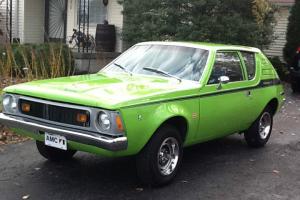 price: $12,207.001972 AMC Gremlin V8 2 Door Coupe Bright Green
price: $12,207.001972 AMC Gremlin V8 2 Door Coupe Bright Green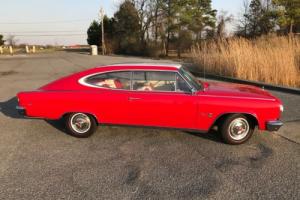 price: $20,000.001965 AMC Marlin
price: $20,000.001965 AMC Marlin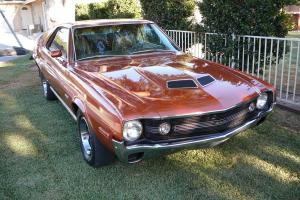 price: $18,325.001970 AMX SURVIVOR LOADED ARIZONA CAR FACTORY A/C
price: $18,325.001970 AMX SURVIVOR LOADED ARIZONA CAR FACTORY A/C
Latest arrivals:
-
$11,995.000
-
$7,500.000
-
$12,999.000
-
$9,600.000
-
$12,000.000
-
$19,000.000
-
$7,500.000
-
$5,500.000
-
$16,500.000
-
$24,000.000
-
$9,000.000
-
$4,000.000
-
$3,400.000
-
$52,500.000
-
$4,850.000
-
$14,500.000
-
$6,500.000
-
$14,500.000
-
$5,100.000
-
$3,153.000
